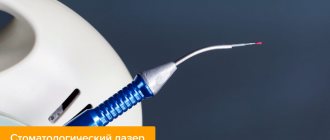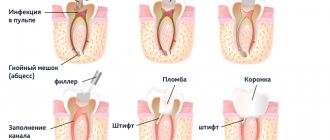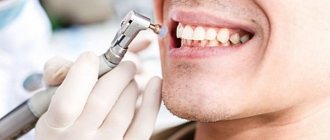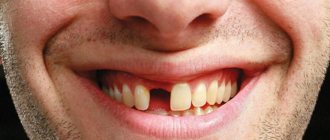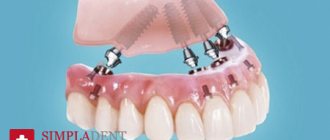Advanced caries, trauma, poor treatment – all these factors are among the most common causes of loss of front teeth. While a person can still come to terms with the absence of a chewing tooth, a hole in the frontal region forces him to immediately seek help from a specialist. Replacement of the anterior group of teeth is a responsible and complex procedure. The doctor faces the difficult task of harmoniously combining three important components - therapeutic, aesthetic and functional. And the best solution to the problem is prosthetics on implants.
Subtleties of implantation of anterior teeth
Anterior tooth implantation has a number of features, since we are talking about the smile zone, an area of increased aesthetic requirements:
- Artificial teeth must be absolutely identical to natural ones (if you are planning an orthopedic system of a lighter shade, you will need to first whiten your teeth).
- The ratio of dental crowns to gums (especially for the upper teeth) is especially carefully taken into account.
- When installing implants, the doctor pays close attention to analyzing the relief of the jaw bone and the thickness of the gums.
- The characteristics of the bite in the frontal zone must be taken into account (some occlusion disorders are an obstacle to implantation.
The main nuances of implanting anterior teeth are related to the fact that the most aesthetic result is expected from a dental prosthetic structure installed in this area, compared to implantation of the chewing group of teeth.
Operation
Medium difficulty
There are contraindications
Doctor's qualifications
High
Indications and contraindications
Indications:
- Missing one or more teeth
- Tooth root fracture
- Impossibility of restoring a dental element using standard methods
- The root must be removed
Contraindications:
- Age up to 18 – 20 years
- Pregnancy or breastfeeding
- Oncology
- AIDS, HIV, tuberculosis
- Blood clotting problems
- Osteomyelitis
- Severe pathologies of the cardiovascular system
- Diabetes
- Mental disorders
- Serious bite defects
- Bruxism
Note: dental and periodontal diseases are also a contraindication for implantation. But when they are cured, the ban on performing the operation automatically disappears. It is also worth mentioning the lack of bone tissue for implant installation. In this case, surgical intervention (osteoplasty or sinus lift) will be required to increase the required volume.
Choosing an implant for the smile area
The front teeth do not take part in chewing food, so special implants are installed in this area, characterized by maximum aesthetics while preserving the volume of bone tissue, minimal trauma to the gums and a shortened healing period.
Such implants are distinguished by their small diameter, as well as a special thread design and coating that stimulates the process of osteogenesis and osseointegration. To avoid the titanium structure showing through the crown or gum, zirconium structures can be used. A ceramic or zirconium prosthesis for tooth restoration replicates the properties of natural enamel, which ensures complete identity with the rest of the dentition.
Work examples
How often do you visit the dentist?
Rating of implant surfaces from different manufacturers
Comparing the production technology and surface characteristics of products from different manufacturers, reviews from doctors and patients, we can name the best manufacturers:
- Nobel-Biocare. They produce dental structures with Ti-Unite surfaces. They undergo sandblasting and acid etching. Hydrophobic properties are removed, the surface is ultra-hydrophilic with a negative charge. The dental implant is adonated in an electrolyte solution, which increases its biocompatibility with the inert tissue of the jaw. After implantation, it is stable; inflammatory processes and rejections occur in less than 4% of patients in the first days after implantation. To shorten the postoperative period and quickly survive, a layer of phosphorus is applied to it.
- They produce dental implants of the Roxolid and G4Ti types with ultra-hybrophilic “SLActive” surfaces. Roxolid structures are made from an alloy of titanium and zirconium dioxide, G4Ti - from pure titanium. They are sandblasted and etched with a company-patented acid composition. Roxolid has the lowest rejection rate, despite the fact that they are often installed in elderly patients and people suffering from diseases that increase the risks of implantation.
- They produce dental structures with OsseoSpeed surfaces. They are sandblasted with titanium dioxide. After such treatment, unlike alumina, there are no foreign impurities left on the surfaces that slow down implantation. At the second stage, treatment with hydrofluoric acid is carried out, after which micropores are formed. Additionally, a dental implant, the price of which is 10-15% higher than the average, is impregnated with fluoride ions, undergoes nanostructuring and eliminates hydrophobic properties.
Shape and carving
To successfully replace a tooth, the implant must be shaped to closely resemble the natural shape of the root. But the root is initially connected to the bone tissue of the jaw; it does not need to be inserted into it. Dental structures for implantation are produced not only in conical, but also in cylindrical shapes. The frequency, depth, and pitch of the thread on them also differ.
Bone tissue can have different densities. The harder it is, the more difficult it is to insert the structure, but the better it holds in the first days. Dense tissue has fewer blood vessels, and the structure takes root more slowly, merging with the bone. If the bone tissue is soft, implants are easier to insert, but they are unstable in the postoperative period, but implantation and the formation of new connective tissue proceed faster.
Bone tissue is divided into 4 types depending on its density. The densest is type D1, the softest is D4. The highest survival rate is in patients with bone tissue type D2, then D3, D1 and D4.
How to choose the shape and thread of implants
Patients with dense bone tissue (D1, D2) are fitted with a cylindrical dental implant, the price of which may be lower than average (if molars, premolars are prosthetic). It is possible to install conical structures (the doctor takes into account not only the density, but also the volume of bone tissue at the site of prosthetics). To reduce trauma to the jaw, manufacturers cut shallow threads with wide pitches. In dense fabric they are held well without additional support and pressure on surrounding tissue. To facilitate their insertion and further survival, the manufacturer AstraTech uses two types of threads on one rod: micro thread in the neck area and shallow thread along the entire length.
Conical implants (for example, NobelActiv, manufactured by NobelBiocare) are inserted into the soft bone tissue (D3, D4). The conical shape increases their stability. The carving is well defined, with a minimum pitch. When they are screwed in, the soft bone tissue becomes denser and better holds the implanted rod.
Implantation of upper teeth
Implantation of the upper jaw is characterized by certain difficulties associated with the anatomical properties of the bone structures in this area. The upper jaw bears less chewing load, so the bone here is looser and thinner than in the mandible.
- Due to the low height of the alveolar ridge, in some cases, even in the absence of an atrophic process, bone tissue parameters are not enough to install an implant, so surgery is necessary to restore the atrophied vestibular volume of the alveolar process.
- The close location of the maxillary and nasal sinuses makes the maxillary bone even more airy and thin, which increases the risk of perforation of the sinus membrane.
- If the parameters of the maxillary bone in the area of the canines and lateral incisors are limited, an operation to build it up (sinus lift) is performed simultaneously with the implantation of an artificial root.
If there are contraindications to one-stage implantation (narrow ridge, insufficient bone volume, etc.), so that the patient does not walk with a hole in the mouth, instead of a crown, a temporary tooth (retainer) is installed, which is fixed with adhesive material to the adjacent teeth.
Possible complications after implantation
During surgery , due to incorrect actions of the doctor or unexpected reactions of the body, the following complications may occur:
- the patient becomes painful due to insufficient anesthesia;
- opening of bleeding in the maxillary sinus;
- excessive bone damage;
- necrosis of the bone structure due to insufficient cooling of the instrument during drilling;
- damage to the mandibular nerve (may occur during restoration of elements of the lower dental row).
In the postoperative period:
- pain in the operated area;
- edema;
- hemorrhage into soft tissues or the oral cavity;
- temperature increase;
- inflammation that develops due to wound infection during the procedure or due to insufficient oral hygiene after it;
- divergence of applied sutures;
- instability of the rod;
- the appearance of increased sensitivity to cold, sweet foods;
- exacerbation of chronic diseases;
- design rejection.
Implantation of lower teeth
Loss of bone tissue in the frontal region is observed quite often. Especially if the tooth has been missing for more than 2 years or was lost due to injury. Since the front teeth do not bear large chewing loads, problems with fixation in the bone are solved due to the design features of the implant, allowing in most cases to do without osteoplastic intervention. In the presence of severe atrophy, implantation of the lower anterior teeth, as well as the upper ones, is carried out simultaneously with osteoplasty.
Service life, manufacturer and clinic warranty
No doctor can give an absolute guarantee of implant survival, because the risk of rejection always exists. The contract for services contains a guarantee from the manufacturer and the clinic. The first varies between 15-30 years, some companies provide lifelong. Applies only to the structure. A new implant will be installed at the manufacturer’s expense if the previous one was rejected due to a manufacturing defect.
The dental guarantee may only last a few years and only covers the work of the implantologist . In this case, the patient is obliged to monitor compliance with all recommendations for the care of dental structures and undergo medical examinations. Otherwise the warranty will be void.
By law, a guarantee for surgical work is not required. If the implantation was unsuccessful, you can only hope for the honesty of the clinic.
Pros and cons of anterior dental implants
| Advantages | Flaws |
| No grinding or depulpation of adjacent healthy teeth is required | There are contraindications |
| Possibility to place an implant immediately after surgical extraction or tooth loss | It is not always possible to do without osteoplastic surgery |
| Rapid engraftment of artificial root | If the implant fails, the likelihood of success of a repeat operation is greatly reduced. |
| Impeccable aesthetics and full functionality of the dentition | Higher risk of complications than with dental implants |
| Unlimited implant lifespan | It takes time for the implant to take root. |
| Prevention of further loss of the jawbone and gradual restoration of its volume | Rehabilitation period |
| The ability to quickly compensate for both single and multiple dental defects in the frontal zone |
What to do if the gums look bad after implantation
After the procedure, the appearance of the gum may change, sometimes it does not form. If this happens, soft tissue plastic surgery is performed. When replacing chewing units, the formation of the correct gingival contour is not necessary, because the changes are not noticeable to others. However, defects that arise after implantation of incisors are clearly visible when smiling or talking. The relevance of plastic surgery increases with prolonged absence of teeth, when the gums have already undergone atrophic changes.
The problem is solved by:
- donor tissue transplants;
- biomaterial of the patient himself;
- artificial membrane.
When performing plastic surgery, the following is noted:
- Complete closure of the wound even with a deficiency of its own tissue.
- Preventing scars.
- The gum is given the required shape and size.
Stages of the procedure
- Diagnostic
Assessment of the volume and general condition of the maxillary bone structures using x-ray diagnostics - orthopantomography and CT with 3D modeling.
- Preparatory
Hygienic cleaning is carried out - all dental deposits are removed, caries and other dental diseases are treated.
- Surgical
The operation is performed under local anesthesia. The operation lasts on average 30-50 minutes; the use of laser equipment significantly reduces the intervention time.
- Orthopedic
After implantation of the implant, an abutment is installed, onto which the adaptive prosthesis is fixed. Permanent dentures are carried out after complete engraftment of the artificial root.
How do implants differ from each other?
In order for the installation of a dental implant to be successful, the doctor must take into account the age, medical status of the patient, the volume and condition of the bone tissue at the site of implantation. Based on these factors, he selects the surgical technique and recommends implants that have a higher chance of survival.
When choosing dental structures, the implantologist takes into account:
- what material they are made of (pure medical titanium or alloys, bioceramics);
- shape (cone or cylinder);
- surface type;
- thread type.
Materials
Economy class dental implants are made from an alloy of titanium with aluminum and vanadium. By adding aluminum and vanadium, manufacturers reduce the cost of products, but due to these impurities, the implant fuses more slowly with the jaw bone tissue. If the patient is young and does not have bad habits or chronic diseases, this has almost no effect on the survival rate of the structure, but the duration of the postoperative period increases. Many patients are willing to undergo treatment a little longer, but cheaper.
If the patient is over 50 years old, has minor abnormalities in the blood composition, or other diseases that are not absolute contraindications to dental implantation, the cost of prosthetics should not be a decisive factor. In such patients, the speed of implantation is reduced, and further slowdown increases the risk of rejection of the structure and the development of inflammatory processes. It is more expedient for them to install more expensive products made of titanium purified from impurities or an alloy of purified titanium with zirconium dioxide. These materials are used by manufacturers Straumann, NobelBiocare, AstraTech, Osstem.
The Straumann company also produces structures from bioceramics. They contain no metals. They can be installed in patients who already have bridges made of different metals or with allergies to metal or certain diseases (leukoplakia). When implanting bioceramic products, microcurrents do not form in the oral cavity.
Bioceramic dental implants, the prices of which are higher, are recommended for prosthetics of incisors and canines, which are visible when talking or smiling. With age, atrophy of the jaw bone tissue occurs, and the implanted structure is covered only by the mucous membrane of the gums. With constant contact with metal, it acquires a bluish tint. When in contact with bioceramics, this effect does not occur, and the gums under the implants and living teeth have the same color.
Surface
The survival rate and comfort of implants is influenced not only by their shape and the material from which they are made, but also by the method of surface treatment. The forms of dental structures are developed by large manufacturers, and smaller ones copy them. It is more difficult to copy the method of surface treatment: some technical solutions are not disclosed, others are known, but their repetition increases the cost of production and the price of dental implants.
The first stage of surface treatment for all manufacturers is sandblasting. It makes the surfaces rough, which improves the exchange of molecules between the implanted product and bone tissue and accelerates their fusion. But different manufacturers use different processing technologies. For economy-class implants, alumina is used, but after contact with it, impurities remain on the surfaces, which impair survival. More expensive designs are treated with titanium oxide.
The second stage is acid etching. When acid hits metal or bioceramic surfaces, it forms micropores ranging in size from 3 to 10 microns. If the implant has been acid etched after sandblasting, it is marked SLA. Manufacturers who limit themselves to the first stage only label their products with RBM.
Acid etching increases survival rate by 20-30% compared to products that have undergone only sandblasting. The primary stability of the structure increases and the risk of its rejection in the first days after implantation is reduced. On surfaces with micropores of 3-10 microns (the size of the pores varies from manufacturer to manufacturer), cells responsible for the growth of bone tissue multiply more actively. The area of contact between the implant and bone tissue increases. The larger the surface area, the more actively the splicing takes place and a stronger connection is formed.
Sandblasting is performed by most manufacturers, and many supplement it with acid etching. But this treatment gives the surfaces hydrophobic properties. They slow down survival and increase the risk of failure. To overcome this disadvantage, manufacturers use negatively charged ultra-hydrophilic SLA surfaces. Additional processing accelerates the deposition of fibrin threads, and the structure fuses with the bone faster.
Another way to improve the characteristics of implants is to treat the surfaces under pressure with phosphorus, calcium phosphate, and fluoride ions. These substances activate the growth of bone tissue around the dental structure and accelerate its growth into metal or bioceramics. Reducing the implantation period reduces the risk of rejection. Before prosthetics, you do not need to wait 3-6 months to obtain a strong connection; it can be done in 2-4 weeks, and in some cases, immediately after implantation.
Which clinic to choose
You can get dental implantation in Moscow at one of the ROOTT MCDI clinics. Installation of a two-stage ROOT implant (Switzerland) at the Moscow Center for Dental Implantology will cost 32,000 rubles. (excluding the cost of the crown), express implantation ROOTT – 44,000 rubles. (together with a temporary crown). You can learn more about the implantation technologies used in order to choose the most preferable option and have an idea of what to be prepared for at a free consultation with an implantologist. Appointments can be made by phone or online.
Modern dentistry offers a number of methods that give patients a chance to regain their beautiful smile. Every year, implant treatment becomes more popular and accessible.
In some cases, when it is necessary to remove a patient's own tooth, most often in the case of front teeth, dentists have the option of inserting an implant into the socket immediately after extraction. Then a “temporary” crown can be installed, thanks to which the patient maintains dental aesthetics, speech and chewing function. After about three months, the temporary crown is replaced with a permanent one, made by a technician in a laboratory. Single-stage implants themselves are slightly different in price from those that are loaded with delayed loading.
You can get advice from experienced specialists about dental implantation in the smile zone in the capital’s dental clinics:
| Clinic address | Clinic | Price |
| Dentistry ROOTT |
|
| Moscow, Kolpachny lane, 6, building 4. | Dentistry Sandora |
|
| Dentistry Prosmail.RU |
|
| Moscow, metro station "Butyrskaya", Rustaveli Street, building 15 | Dental Clinic Dention |
|
| Moscow, metro station Barrikadnaya st. Zoologicheskaya, 2, under. 9 | Dentistry DENTAL DREAM |
|
| Moscow, Zvenigorodskoye sh., 7 | Dentistry Implant Expert | Nobel implantation, USA, from 50,000 rubles, Astra Tech implantation, Sweden from 47,200 rubles, OSSTEM Korea - 27,000 rubles |
| Moscow, Bolshoi Sergievsky lane, 5 | Dentistry Viva-dent | Dental implantation depending on complexity: 31,000 - 41,000 rubles per 1 tooth |
| Moscow, st. Molodtsova, 2a | Family discount dentistry | Implantation is carried out using various systems - Astra Tech (Sweden), Ankylos Densply (Germany), Dentium (Korea), the price for 1 restored tooth is from 30,000 rubles. |
| Moscow, Paveletskaya sq., 1 | Dental Clinic Denta VIP | Implantation of the IMPLA system (Germany), OSSTEM (Korea) - from 36,000 rubles. Astra Tech (Sweden) – from 45,000 rubles. |
| Moscow, st. Lyublinskaya, 161 | Dentistry PRESIDENT |
|
Dental implants are the latest technologies that provide exceptional comfort of use. Patients who have lost their front teeth due to an accident, tooth decay, or other diseases can enjoy the ability to function normally and smile without fear, without discomfort, thanks to dental implants. The most modern method of replacing missing teeth is implantation.
Dental implants are placed when we lose our natural teeth. Most often, the decision to replace missing front teeth is made for aesthetic reasons. It's no secret that missing teeth can lead to changes in our appearance, or rather, facial features. You can see the appearance of your cheeks, mouth and nose change. Wrinkles appear faster in the middle part of the face, which makes us feel unattractive.
However, it is worth remembering that from a medical point of view, the replacement of missing teeth, both front and back, is very important. The absence of teeth disrupts the functioning of the chewing system, which over time affects both aesthetics and our health. The absence of molars causes improper grinding of food, which leads to the development of diseases of the digestive system, such as peptic ulcers or increased stomach acidity.
Which method is better to use
When choosing an implantation method, aesthetics and the speed of implant survival (osseointegration) play an important role. Therefore, they try to give preference to a one-step technique, when the implant is installed in place of the natural root after tooth extraction. After implantation into the tissue, a temporary crown with chewing load is immediately installed. The permanent crown is installed after healing. This promotes rapid osseointegration and prevents jaw bone atrophy.
If the natural root has been absent for a long time, then implantation has to be done in two stages: first, an implant is implanted and the wound over it is sutured, and then, after osseointegration is completed, an abutment and a permanent prosthesis are installed. To avoid a hole in the smile area, the patient is prescribed to wear a butterfly prosthesis made of acrylic. If we are talking about complete implantation, when not only the front teeth are missing, but also the chewing teeth, it is better to use the All-on-4 method.
Features of implantation of anterior teeth
The success of implantation of anterior teeth consists of: the knowledge and skills of the doctor, choosing the optimal solution together with the patient, a high-quality implant, professional prosthetics of the implant, the condition and amount of bone, the general health of the patient, as well as postoperative procedures - compliance with recommendations during the healing period and impeccable hygiene during throughout the entire period of use. However, despite the fact that many factors influence the final result, the effectiveness of such treatment is very high.
To get a consultation
Frontal prosthetics: implantation
Prosthetics of the frontal area of the upper jaw using dental implants is the most complex procedure in modern dentistry, and not only because it requires a certain level of knowledge and skills from a surgeon and orthopedist. To a greater extent, this is due to the increased aesthetic expectations of the patient, who is not ready to put up with even minimal visual discomfort, which would indicate the presence of something unnatural in the oral cavity (according to the authors’ observation, even with a low smile line).
Today, absolutely all patients of our clinic are extremely demanding about the results of prosthetics on implants in the frontal area.
This is largely due to the increased amount of information that our patients receive via the Internet, from various forums and simply publications. In some cases, such information is, unfortunately, far-fetched, since some dentists make “mystical” conclusions, refusing the opportunity to learn from the experience of recognized masters, whose books are no longer in short supply in Russia.
The purpose of this publication is to confirm those common truths, without which prosthetics on implants in aesthetically significant areas is simply unthinkable.
Preparation for implantation. Planning.
Planning of the entire treatment begins with communication between the orthopedic surgeon and the dental technician as the main team players with the patient, where the main attention is paid not to the possible development of the situation during implantation or subsequent prosthetics, but to the following factors:
- patient expectations,
- smoking,
- smile line height,
- gum biotype,
- the shape of the remaining or restored teeth,
- infection in the area of upcoming implantation,
- orthopedic status of the teeth adjacent to the defect area, type of dentition defect,
- width of bone and soft tissue in the edentulous area,
- height of bone and soft tissue in the edentulous area.
After detailing the patient’s specific wishes, the orthopedic doctor is obliged to confirm or deny the possibility of obtaining the requested result.
Alas, it is worth recognizing that in most cases such communication is absent, and there is only one reason - to earn money at any cost and install an implant as soon as possible after the first request. However, after a long and unsuccessful treatment, a fiasco often sets in for both the doctor and the unfortunate patient!
Implantation can be immediate after tooth extraction, or delayed, no less than two months later - as a rule, after tooth extraction in case of acute or exacerbated chronic infectious inflammation. Let's look at a number of proven rules that will allow us to talk about successful surgical treatment.
Tooth extraction and immediate implantation
The basic rule that a surgeon should never violate is atraumatic removal, which will allow preserving the alveolar vestibular wall and installing an implant. In this regard, elevators and forceps cannot be used without first fragmenting the tooth with cutters and working with periotomes.
After the tooth is removed, the doctor needs to make sure, through simple probing, that the anterior wall of the alveoli is intact - in the case of obvious and pronounced fenestrated defects, implantation is impossible.
When installing an implant, you must remember that the use of implant diameters of more than 4.5 mm is highly recommended! The judgment of some Russian surgeons is erroneous that if the size of the socket allows the installation of implants up to or more than 5 mm, then this is justified by the ideal primary stabilization of the implant. However, in the foreseeable future, contact of the implant to the vestibular wall of the alveolus, even in the upper third of the socket, will lead to resorption of the wall, which in turn will cause an unsatisfactory aesthetic result.
Primary stabilization of the implant is probably the main factor influencing the positive outcome of the entire treatment, but it is unacceptable to achieve it by bicortical wedging of the implant in the socket of the extracted tooth. All that needs to be done is to deepen the hole by at least 3-4 mm and shift the axis of the implant palatally so that there is no contact with the anterior wall of the alveolus along its entire length (Fig. 2).
The distance between the implant and the anterior wall should be between 1.5 and 2 mm. If this distance exceeds the specified value, then we recommend using autogenous bone mixed in equal proportions with the Bio-Oss material, since the latter will act as a scaffold to support the autogenous bone.
The flap is folded back, it is planned to remove 11 and 21 with simultaneous implantation (Fig. 3).
Teeth 11 and 21 were removed (Fig. 4).
Biohorizon implants with a diameter of 3.8 were installed (Fig. 5).
A correctly made template allows you to position not only the axis, but also the location of the implant neck (Fig. 6).
The position of the implants shifted in the palatal direction is clearly visible in Fig. 7.
Autogenous bone from the mandibular ramus is mixed with Bio-Oss and tightly condensed between the implant and the alveolus (Fig. 8-10).
Temporary prosthetics with immediate implantation
Temporary prosthetics using a fixed structure, such as screw-retained crowns to achieve an aesthetic result and social rehabilitation of the patient, is only possible with good fixation of the implant. If there is the slightest doubt about this, as well as during NTR, we recommend suturing the implant and fixing the Maryland structure.
Temporary implant prosthetics can be performed with cement or screw fixation, when a temporary plastic abutment acts as the core of the crown, onto which the technician presses acrylic material (Fig. 11).
Personally, I do not recommend making cement-retained temporary crowns on temporary abutments that have not been customized to the gingival contour. They have nothing to do with the anatomy of the operated area, since the unpredictability of the degree of immersion of the crown edge towards the implant neck and, as a consequence, the release of temporary cement in close proximity to the latter, can lead to the occurrence of peri-implantitis.
Screw fixation
Screw-retained crowns can be made either directly by the doctor in the clinic during the patient’s appointment, or in the laboratory.
The ability to use the direct method is a necessary tool in the orthopedic arsenal, which can be used either due to the distance of the laboratory from the clinic, or in the event of unexpected removal and installation of an implant, and the inability to release the patient without a temporary restoration.
The advantages of the direct method over the laboratory method include the ability to control the necessary support of soft tissues in the cervical area, low cost, and timing.
The disadvantages are not very high or even low aesthetics.
It should be noted that using the screw fixation method should not be done with caution. The number of unscrewing and screwing of such crowns should be limited, especially with a thin gum biotype, since (especially on poorly polished structures) large recessions are possible due to the resulting false attachment and constant trauma.
The laboratory method involves taking an impression and, after receiving a plaster model from the laboratory, remodeling the gingival margin according to the required aesthetic contour (see laboratory method below). After the acrylic crowns are ready, the doctor performs anesthesia in the area of the implants and screws them until gum ischemia occurs (RVG control is required).
It is important to remember that this design should only apply pressure to soft tissue. In the case of such pressure on the underlying bone, a powerful pain syndrome always develops with prolonged inflammation and, as a consequence, serious recession (Fig. 12-13).
The remodeling of tissues in the oral cavity takes from 4 to 6 weeks and, with a sufficient amount of attached gum, always demonstrates a 100% result, which consists of a perfect imitation of the natural gingival margin. However, if prosthetics of teeth adjacent to implants is also planned, the dentist must remember that without immersing the ledge under the gingival area from the proximal sides at the border with the implants, he risks losing the gingival papilla due to the lack of its support.
To illustrate these theoretical constructs, let me give a small example.
Clinical case
Patient 29 years old, 11 – fracture in the lower third.
After a detailed analysis of the situation in the presence of a dental technician (Dmitry Nikonenko), a decision was made to remove 11 with the immediate installation of an implant, a temporary crown with screw fixation and prosthetics of 4 incisors after 6 months.
After this period, we began endodontic treatment 21 and the production of a core inlay. It was decided to make an individual abutment and two crowns on zirconium dioxide frames for teeth 11 and 21, and for vital teeth 12 and 22 - frameless crowns with a thickness of no more than 0.5 mm! (Fig. 14-17).
Despite the excellent epithelialization, before fixing the crowns, it is necessary to place an unimpregnated retraction cord with a diameter of no more than 000 or 00 between the abutment, teeth and gum to capture excess cement.
Using the positioner in RVG, you can see the facts of “under-fitting” of the crown frame on the abutment or teeth! Pay attention to the distorted image 17a, where it may seem to an inexperienced doctor that the position of the crown on the abutment is ideal, but with the correct positioning of the positioner, a gap is visible in the medial-proximal zone of the crown on the 11th tooth.
Rice. 18 – crowns fixed with self-etching and self-adhesive cement after 7 days.
The situation after three months is shown in Fig. 19.
After a year the situation looks like this - Fig. 20.
Neither the dentist, nor the technician, nor the patient has any complaints about the work performed. But this is the frontal zone...
Author:
Ordzhonikidze G.Z., orthopedic dentist (Moscow)
